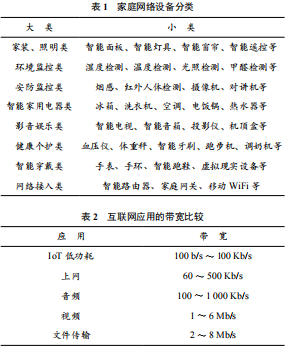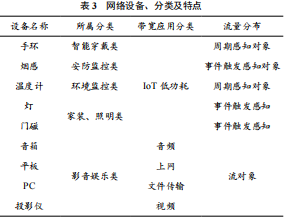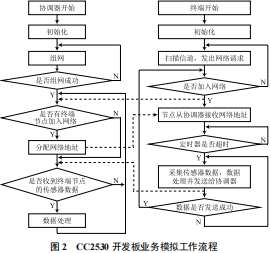(Shanghai Broadband Technology and Application Engineering Research Center, Shanghai 200436)
Abstract: Smart home devices are making home networks increasingly complex. This article starts from two aspects: the types of smart home network devices and their traffic characteristics. It selects some representative and easy-to-operate real terminal devices, builds a home network simulation environment using a self-made smart terminal gateway device with IoT development boards, virtual terminal devices, and various background traffic generated by application software. Then, it develops corresponding analysis applications on the gateway device to monitor the network and runs a home network management system on the server for network operation and maintenance management.
Keywords: Home Network; Internet of Things; ZigBee; BLE; Network Operation and Maintenance Management; WiFi
Classification Number: TP39 Document Identification Code: A
Article Number: 2095-1302 (2022) 10-0033-03
Both wired and wireless home networks are defined as “two or more nodes that can communicate with each other directly or through relay nodes at the physical layer or through inter-domain bridges at the physical layer” [1]. The new generation of humans and the trend of an aging society have created a significant demand for smart home devices, leading to a variety of increasingly complex smart devices appearing in home networks, growing at a rate of 20% to 30% annually [2]. With the introduction of advanced devices and services, home networks are becoming more complex, leading to network congestion as more devices compete for limited resources, services, and bandwidth. In terms of network management, it is essential to adopt network segmentation and effective bandwidth allocation strategies to improve the quality of service in home IoT networks [3].
Researching home network technology and simulating it is of great significance for studying various characteristics and future developments of home networks. This article constructs a smart home network model and experimental environment that conforms to the existing home network rules, starting from the types of devices in existing home networks and network traffic characteristics. It adds multiple device simulation tools at various levels of the network to enhance the authenticity of the network environment and conducts network functionality testing in that environment.
1.1 Devices and Their Traffic
The number of home network devices is increasing daily, including smart wearable devices that monitor health features, smart refrigerators that store food, and various household devices such as lighting and security systems. People’s daily lives are almost inseparable from these devices. We categorize these devices into eight major categories based on their functions and usage scenarios, with each major category further divided into several subcategories. Table 1 shows the classification methods and common devices in each category.
Among the many home network devices, the network protocols used also vary in focus. Some devices, although large, have simple embedded network modules, such as home appliances, most of which embed low-power IoT network modules. Other devices, though smaller, generate significant and diverse network traffic, such as tablets, where different applications produce various types of application traffic. The bandwidth requirements of different network applications are listed in Table 2 [4]. From a macro perspective, the vast majority of home network bandwidth is occupied by Internet applications and audio-visual content, while IoT terminals occupy only a small portion of the bandwidth, resulting in an overall home network traffic exhibiting a non-persistent characteristic [5].
2 Network Environment Construction
The simulation of the home IoT network must cover three home IoT protocols: WiFi, ZigBee, and Bluetooth; the network functions must include common functions in home networks: communication functions, information sharing and management, home automation, external network access, home entertainment, and other value-added services. In addition to striving to be close to a real environment, the network protocols and functional services must also leave corresponding interfaces for later management and testing in network research and testing. Therefore, both terminals and gateways use some self-made devices.
Based on the types of devices and their traffic characteristics, we constructed the network experimental environment as shown in Figure 1. In Figure 1, the gateway, Bluetooth, WiFi, and ZigBee belong to the network access category; external networks and servers belong to other devices; the “simulation devices” can be defined through application development as various household devices such as appliances and health care, enriching the home network experimental scenarios by embedding “simulation devices” at various levels of the network, connecting them to Bluetooth and ZigBee gateways as real smart home devices. The “simulation devices” connect to WiFi and gateways, generating Internet Protocol (IP) background traffic for testing home network traffic scheduling, etc.
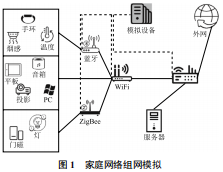 In selecting devices, we aim to cover various types. For some large and complex household appliances, we simulate their traffic sending, receiving, and processing processes through software applications. Further explanations on the selection of devices in the experimental environment can be found in Table 3. Here, we refer to literature [6] to classify device traffic distribution into three types: periodic sensing objects, event-triggered sensing objects, and flow objects.
The network functions are reflected in the following ways:
(1) Communication function: Install network management applications on devices such as PCs, gateways, and servers to detect network metrics such as latency, jitter, and packet loss;
(2) Information sharing and management: Store various types of files such as videos and audio on the server, perceive and store various information sent by IoT devices for sharing among all smart terminals;
(3) Home automation: Install some home assistant applications on the server to enable terminal devices to work collaboratively, for example, linking door sensors and lights so that the light automatically turns on when the door opens;
(4) External network access: Smart home terminal devices can access the Internet, sending perceived information to cloud servers according to predefined rules;
(5) Home entertainment: Download online videos and other resources to the server through the gateway, and then share them with devices such as PCs and projectors;
(6) Other value-added services: Through traffic strategies, allocate resources on demand for devices with high bandwidth requirements such as games and movies.
3 Simulation Device Construction
During the network construction process, we analyzed home network devices, networking methods, and their functions. For specific terminal devices, we mainly selected some simple and common home network devices as real terminals, most of which are simulated using development boards. This section mainly studies the implementation of simulation devices and experimental methods, using tools such as OpenWrt, Raspberry Pi, CC2530, and ESP32 for service simulation [7-10]. The CC2530 development board simulates communication between ZigBee device terminals and coordinators, while the ESP32 development board simulates communication between Bluetooth Low Energy (BLE) device terminals and gateways, and the Raspberry Pi simulates background traffic between terminals and routers.
Using customized simulation devices facilitates later network analysis, allowing easy writing of custom applications for various data collection and the ability to define various traffic strategies for network management.
Both coordinator and terminal nodes are CC2530 development boards, using TI’s Z-Stack protocol stack for communication, with the workflow shown in Figure 2. The coordinator acts as the core device, capable of receiving data from various ZigBee terminals, while the terminal devices simulate nodes that periodically send data for testing the ZigBee protocol and its impact on the entire network.
Using two ESP32 development boards to test BLE functionality, the ESP32 integrates BLE and WiFi functionalities, one simulating the gateway device and the other simulating the terminal device. The gateway scans and adds the terminal device, subscribing to the broadcast information sent by the terminal device, receiving, parsing, and reorganizing it before sending it to the server. Various business function simulation modules run concurrently on the terminal development board.
In selecting devices, we aim to cover various types. For some large and complex household appliances, we simulate their traffic sending, receiving, and processing processes through software applications. Further explanations on the selection of devices in the experimental environment can be found in Table 3. Here, we refer to literature [6] to classify device traffic distribution into three types: periodic sensing objects, event-triggered sensing objects, and flow objects.
The network functions are reflected in the following ways:
(1) Communication function: Install network management applications on devices such as PCs, gateways, and servers to detect network metrics such as latency, jitter, and packet loss;
(2) Information sharing and management: Store various types of files such as videos and audio on the server, perceive and store various information sent by IoT devices for sharing among all smart terminals;
(3) Home automation: Install some home assistant applications on the server to enable terminal devices to work collaboratively, for example, linking door sensors and lights so that the light automatically turns on when the door opens;
(4) External network access: Smart home terminal devices can access the Internet, sending perceived information to cloud servers according to predefined rules;
(5) Home entertainment: Download online videos and other resources to the server through the gateway, and then share them with devices such as PCs and projectors;
(6) Other value-added services: Through traffic strategies, allocate resources on demand for devices with high bandwidth requirements such as games and movies.
3 Simulation Device Construction
During the network construction process, we analyzed home network devices, networking methods, and their functions. For specific terminal devices, we mainly selected some simple and common home network devices as real terminals, most of which are simulated using development boards. This section mainly studies the implementation of simulation devices and experimental methods, using tools such as OpenWrt, Raspberry Pi, CC2530, and ESP32 for service simulation [7-10]. The CC2530 development board simulates communication between ZigBee device terminals and coordinators, while the ESP32 development board simulates communication between Bluetooth Low Energy (BLE) device terminals and gateways, and the Raspberry Pi simulates background traffic between terminals and routers.
Using customized simulation devices facilitates later network analysis, allowing easy writing of custom applications for various data collection and the ability to define various traffic strategies for network management.
Both coordinator and terminal nodes are CC2530 development boards, using TI’s Z-Stack protocol stack for communication, with the workflow shown in Figure 2. The coordinator acts as the core device, capable of receiving data from various ZigBee terminals, while the terminal devices simulate nodes that periodically send data for testing the ZigBee protocol and its impact on the entire network.
Using two ESP32 development boards to test BLE functionality, the ESP32 integrates BLE and WiFi functionalities, one simulating the gateway device and the other simulating the terminal device. The gateway scans and adds the terminal device, subscribing to the broadcast information sent by the terminal device, receiving, parsing, and reorganizing it before sending it to the server. Various business function simulation modules run concurrently on the terminal development board.
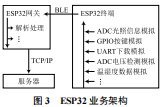 The BLE traffic and ZigBee traffic are ultimately converted into IP traffic for transmission in the network. Therefore, it is possible to study the impact of IoT traffic on the network by directly generating IP traffic. When researching home network functionality and performance, it is challenging to conduct extreme scenarios such as network attacks and stress tests solely using network devices. However, generating corresponding scenarios through simulation devices producing background traffic is relatively easier. By studying various traffic generation models, we use the Raspberry Pi as a simulation device, installing the Ubuntu operating system and developing a traffic generator to produce various background traffic [11]. The wireless router uses the OpenWrt operating system, facilitating status collection and policy deployment, with hardware using Raspberry Pi 4 or other home routers that support OpenWrt firmware.
The functional architecture for simulating IP traffic using the Raspberry Pi is shown in Figure 5.
This article first analyzes the common network terminal devices in existing homes, categorizing them, then analyzes the traffic characteristics of existing home networks, and finally selects some representative and easy-to-operate devices for networking. For devices that cannot be presented in the simulation environment, we use development boards for virtual simulation and add background traffic in the network to simulate real home network traffic. The following three aspects will be further explored:
(1) Adding edge computing simulation to the simulation environment to study the role of edge computing in the evolution of home networks;
(2) Researching a family-oriented Information and Communication Technology (ICT) integrated home network management solution to address the increasing operational and maintenance issues in home networks;
(3) Using this network environment to study and simulate various application scenarios, such as presence and absence of people at home, dynamic changes in alarm methods, etc.
The BLE traffic and ZigBee traffic are ultimately converted into IP traffic for transmission in the network. Therefore, it is possible to study the impact of IoT traffic on the network by directly generating IP traffic. When researching home network functionality and performance, it is challenging to conduct extreme scenarios such as network attacks and stress tests solely using network devices. However, generating corresponding scenarios through simulation devices producing background traffic is relatively easier. By studying various traffic generation models, we use the Raspberry Pi as a simulation device, installing the Ubuntu operating system and developing a traffic generator to produce various background traffic [11]. The wireless router uses the OpenWrt operating system, facilitating status collection and policy deployment, with hardware using Raspberry Pi 4 or other home routers that support OpenWrt firmware.
The functional architecture for simulating IP traffic using the Raspberry Pi is shown in Figure 5.
This article first analyzes the common network terminal devices in existing homes, categorizing them, then analyzes the traffic characteristics of existing home networks, and finally selects some representative and easy-to-operate devices for networking. For devices that cannot be presented in the simulation environment, we use development boards for virtual simulation and add background traffic in the network to simulate real home network traffic. The following three aspects will be further explored:
(1) Adding edge computing simulation to the simulation environment to study the role of edge computing in the evolution of home networks;
(2) Researching a family-oriented Information and Communication Technology (ICT) integrated home network management solution to address the increasing operational and maintenance issues in home networks;
(3) Using this network environment to study and simulate various application scenarios, such as presence and absence of people at home, dynamic changes in alarm methods, etc.
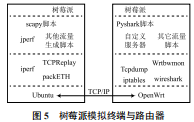
Note: The corresponding author of this article is Hongyi Zhu.
References
[1] Kirichek R, Golubeva M, Kulik V, et al. The home network traffic models investigation [C]// 2016 18th International Conference on Advanced Communication Technology (ICACT). IEEE, 2016.
[2] Huang Qianyi, Li Zhiyang, Xie Wentao, et al. Edge computing in smart homes [J]. Computer Research and Development, 2020, 57(9): 1800-1809.
[3] Zhang Y, Yu R, Xie S, et al. Home M2M networks: Architectures, standards, and QoS improvement [J]. Communications magazine IEEE, 2011, 49(4): 44-52.
[4] Lech P, Wodarski P. IoT WiFi Home Network Stress Test [C]// International Conference on Image Processing and Communications. Springer International Publishing, 2017.
[5] Kirichek R, Golubeva M, Kulik V, et al. The home network traffic models investigation [C]// 2016 18th International Conference on Advanced Communication Technology (ICACT). IEEE, 2016.
[6] Attia M B, Nguyen K K, Cheriet M. Dynamic QoS-aware Queuing for Heterogeneous Traffic in Smart Home [C]// 2019 15th International Wireless Communications & Mobile Computing Conference (IWCMC). IEEE, 2019.
[7] Yan Minru, Zhou Ping, Wang Kai. Design of Smart Home System Based on Raspberry Pi [J]. Software Guide, 2020, 19(7): 94-98.
[8] Xu Zhexin, Zhang Yilin, Lin Xiao, et al. Design of Smart Home Router Based on OpenWrt and ZigBee [J]. Computer Engineering, 2017, 43(3): 94-98.
[9] Xie Xiaokang, Zhang Jing. Design of Smart Home System Based on ZigBee Technology [J]. Internet of Things Technology, 2016, 6(12): 69-72.
[10] Mao Haolong, Ai Hong. Design and Implementation of Smart Home Project Based on ESP32 [J]. Industrial Instruments and Automation Devices, 2021, 51(2): 126-130.
[11] Fang Xi, Zeng Jianping, Wu Chengrong. Overview of Background Traffic Generation Models [J]. Computer Applications, 2019, 39(s1): 124-131.
Xiang’an Sun (1987—), male, from Guanyun, Jiangsu, master’s degree, senior software engineer, main research direction is SDN controller development.
